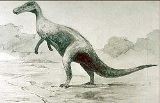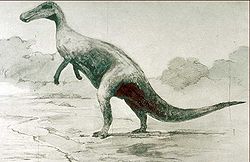
Thespesius
Encyclopedia
Thespesius is a dubious
genus
of hadrosaurid
dinosaur
from the late Maastrichtian
-age Upper Cretaceous Lance Formation
of South Dakota
.
In 1855 geologist Ferdinand Vandiveer Hayden sent a number of fossils to paleontologist Joseph Leidy
in Philadelphia. Hayden had collected them in an area within present-day South Dakota, then Nebraska Territory
, near the Grand River
. Among them were two caudal
vertebrae and a phalanx
. In 1856 Leidy named the type species
Thespesius occidentalis for these three bones. The generic name is derived from Greek θεσπεσιος, thespesios, "wondrous", because of the colossal size of the remains. Leidy avoided using the suffix "saurus" in the genus name because Vandiveer Hayden had claimed the bones came from a layer from the Miocene
so there was a chance that the animal would turn out to be a mammal
, though Leidy himself was convinced it was a "deinosaurian". The specific name means "western" in Latin
.
The caudal vertebrae, USNM 219 and USNM 221, and the middle toe phalanx, USNM 220, form the syntype
series.
 Like Trachodon
Like Trachodon
, another duckbill genus named by Joseph Leidy
, Thespesius is an historically-important genus with a convoluted taxonomy that has been all but abandoned by modern dinosaur paleontologists. Around 1900 the name was used by some authors to indicate all late Maastrichtian hadrosaurids, which led to a great number of existing species being assigned to Thespesius.
Two other species
of duckbill started out as species of Thespesius: T. saskatchewanensis, now thought to be a species of Edmontosaurus
(and included in Anatosaurus for many years); and T. edmontoni, now considered to be the same as Edmontosaurus annectens.
Nomen dubium
In zoological nomenclature, a nomen dubium is a scientific name that is of unknown or doubtful application...
genus
Genus
In biology, a genus is a low-level taxonomic rank used in the biological classification of living and fossil organisms, which is an example of definition by genus and differentia...
of hadrosaurid
Hadrosaurid
Hadrosaurids or duck-billed dinosaurs are members of the family Hadrosauridae, and include ornithopods such as Edmontosaurus and Parasaurolophus. They were common herbivores in the Upper Cretaceous Period of what are now Asia, Europe and North America. They are descendants of the Upper...
dinosaur
Dinosaur
Dinosaurs are a diverse group of animals of the clade and superorder Dinosauria. They were the dominant terrestrial vertebrates for over 160 million years, from the late Triassic period until the end of the Cretaceous , when the Cretaceous–Paleogene extinction event led to the extinction of...
from the late Maastrichtian
Maastrichtian
The Maastrichtian is, in the ICS' geologic timescale, the latest age or upper stage of the Late Cretaceous epoch or Upper Cretaceous series, the Cretaceous period or system, and of the Mesozoic era or erathem. It spanned from 70.6 ± 0.6 Ma to 65.5 ± 0.3 Ma...
-age Upper Cretaceous Lance Formation
Lance Formation
The Lance Formation is a division of Late Cretaceous rocks in the western United States. Named after Lance Creek, Wyoming, the microvertebrate fossils and dinosaurs represent important components of the latest Mesozoic vertebrate faunas...
of South Dakota
South Dakota
South Dakota is a state located in the Midwestern region of the United States. It is named after the Lakota and Dakota Sioux American Indian tribes. Once a part of Dakota Territory, South Dakota became a state on November 2, 1889. The state has an area of and an estimated population of just over...
.
In 1855 geologist Ferdinand Vandiveer Hayden sent a number of fossils to paleontologist Joseph Leidy
Joseph Leidy
Joseph Leidy was an American paleontologist.Leidy was professor of anatomy at the University of Pennsylvania, and later was a professor of natural history at Swarthmore College. His book Extinct Fauna of Dakota and Nebraska contained many species not previously described and many previously...
in Philadelphia. Hayden had collected them in an area within present-day South Dakota, then Nebraska Territory
Nebraska Territory
The Territory of Nebraska was an organized incorporated territory of the United States that existed from May 30, 1854, until March 1, 1867, when the final extent of the territory was admitted to the Union as the State of Nebraska. The Nebraska Territory was created by the Kansas–Nebraska Act of 1854...
, near the Grand River
Grand River (South Dakota)
The Grand River is a tributary of the Missouri River in North Dakota and South Dakota in the United States. The length of the combined branch is 110 mi...
. Among them were two caudal
Tail
The tail is the section at the rear end of an animal's body; in general, the term refers to a distinct, flexible appendage to the torso. It is the part of the body that corresponds roughly to the sacrum and coccyx in mammals, reptiles, and birds...
vertebrae and a phalanx
Phalanx bones
In anatomy, phalanx bones are those that form the fingers and toes. In primates such as humans and monkeys, the thumb and big toe have two phalanges, while the other fingers and toes consist of three. Phalanges are classified as long bones.The phalanges do not have individual names...
. In 1856 Leidy named the type species
Type species
In biological nomenclature, a type species is both a concept and a practical system which is used in the classification and nomenclature of animals and plants. The value of a "type species" lies in the fact that it makes clear what is meant by a particular genus name. A type species is the species...
Thespesius occidentalis for these three bones. The generic name is derived from Greek θεσπεσιος, thespesios, "wondrous", because of the colossal size of the remains. Leidy avoided using the suffix "saurus" in the genus name because Vandiveer Hayden had claimed the bones came from a layer from the Miocene
Miocene
The Miocene is a geological epoch of the Neogene Period and extends from about . The Miocene was named by Sir Charles Lyell. Its name comes from the Greek words and and means "less recent" because it has 18% fewer modern sea invertebrates than the Pliocene. The Miocene follows the Oligocene...
so there was a chance that the animal would turn out to be a mammal
Mammal
Mammals are members of a class of air-breathing vertebrate animals characterised by the possession of endothermy, hair, three middle ear bones, and mammary glands functional in mothers with young...
, though Leidy himself was convinced it was a "deinosaurian". The specific name means "western" in Latin
Latin
Latin is an Italic language originally spoken in Latium and Ancient Rome. It, along with most European languages, is a descendant of the ancient Proto-Indo-European language. Although it is considered a dead language, a number of scholars and members of the Christian clergy speak it fluently, and...
.
The caudal vertebrae, USNM 219 and USNM 221, and the middle toe phalanx, USNM 220, form the syntype
Syntype
In biological nomenclature, a syntype is a term used to indicate a specimen with a special status.In zoological nomenclature, a syntype is defined as "Each specimen of a type series from which neither a holotype nor a lectotype has been designated [Arts. 72.1.2, 73.2, 74]. The syntypes...
series.
Classification

Trachodon
Trachodon is a dubious genus of hadrosaurid dinosaur based on teeth from the Campanian-age Upper Cretaceous Judith River Formation of Montana, U.S.A...
, another duckbill genus named by Joseph Leidy
Joseph Leidy
Joseph Leidy was an American paleontologist.Leidy was professor of anatomy at the University of Pennsylvania, and later was a professor of natural history at Swarthmore College. His book Extinct Fauna of Dakota and Nebraska contained many species not previously described and many previously...
, Thespesius is an historically-important genus with a convoluted taxonomy that has been all but abandoned by modern dinosaur paleontologists. Around 1900 the name was used by some authors to indicate all late Maastrichtian hadrosaurids, which led to a great number of existing species being assigned to Thespesius.
Two other species
Species
In biology, a species is one of the basic units of biological classification and a taxonomic rank. A species is often defined as a group of organisms capable of interbreeding and producing fertile offspring. While in many cases this definition is adequate, more precise or differing measures are...
of duckbill started out as species of Thespesius: T. saskatchewanensis, now thought to be a species of Edmontosaurus
Edmontosaurus
Edmontosaurus is a genus of crestless hadrosaurid dinosaur. It contains two species: Edmontosaurus regalis and Edmontosaurus annectens. Fossils of E. regalis have been found in rocks of western North America that date from the late Campanian stage of the Cretaceous Period 73 million years ago,...
(and included in Anatosaurus for many years); and T. edmontoni, now considered to be the same as Edmontosaurus annectens.

